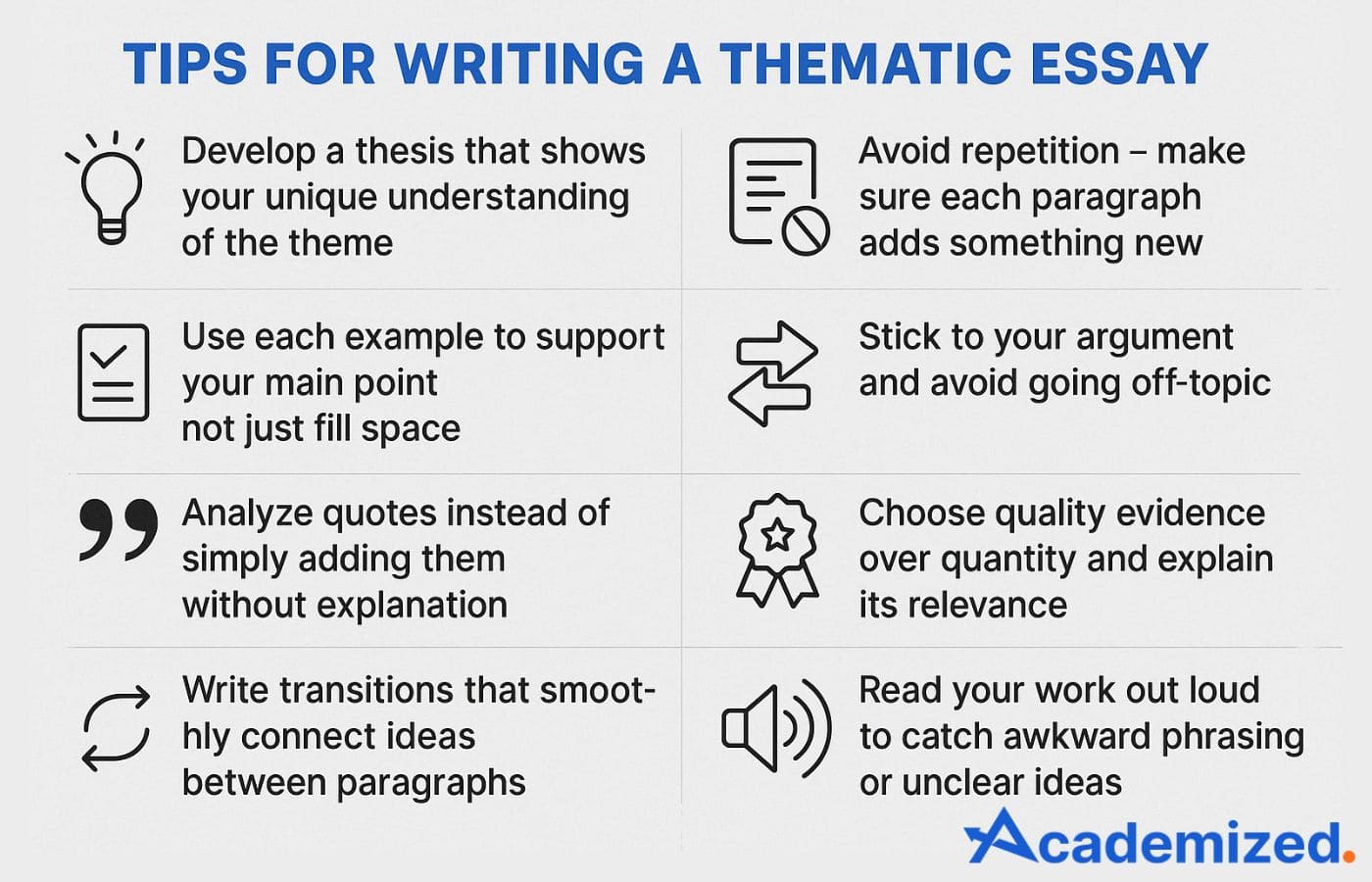- Blog
- How to Write a Thematic Essay: Guide for Students (With Steps)
How to Write a Thematic Essay: Guide for Students (With Steps)
 Mary Watson
Mary Watson

Writing a thematic essay can feel challenging if you’re unsure where to begin. However, how to write a good thematic essay? To craft a strong thematic essay, you must identify a central theme, use clear evidence, and explain how that theme develops throughout your chosen texts or topics.
A thematic essay isn’t just about summarizing a story or event but exploring the underlying message or idea. Whether you're analyzing a novel, historical movement, or social issue, the goal is to show how the theme connects different elements and why it matters. With the proper structure and examples, your writing can clearly express your understanding and make your essay more impactful.
This guide’ll explain the steps we recommend for writing a thoughtful, well-organized, and easy-to-follow thematic essay.
Breaking Down the Thematic Essay
A thematic essay is a type of academic writing that centers on a single theme or message. Rather than focusing on surface-level details, it dives into the deeper meaning behind a subject. You’ll often see this type of essay assigned in literature, history, or social studies classes, where understanding key ideas is more important than recalling facts.
The goal is to explore how a theme is developed and expressed through examples like texts, historical events, or real-life issues. Writers must show clear connections between evidence and the main message. Instead of just describing what happened, you must explain why it matters and how it fits into the bigger picture.
Core Elements That Make a Thematic Essay Work
Great thematic essays have certain qualities that make them stand out. They don’t just present information – they build a focused argument around a clear idea. To create a strong thematic essay, keep these key features in mind:
- A clearly defined theme that appears consistently throughout the essay – not just in the introduction
- Well-developed analysis that explains how each example supports the theme, rather than simply stating facts
- A logical structure with an introduction that sets the tone, body paragraphs that expand the argument, and a conclusion that brings it all together
- Smooth transitions between paragraphs to maintain clarity and keep the reader engaged
- Academic tone and clear language that avoids confusion and presents ideas with purpose
When all these elements work together, the essay becomes more than just a response to a prompt – it shows real understanding and communicates your ideas in a way that’s easy to follow and hard to forget.
Innovative Strategies for Picking the Right Theme
A strong theme makes or breaks a thematic essay. Your chosen topic should allow for thoughtful exploration and connect to issues or ideas that matter. If a theme is too broad, it becomes hard to manage. If it’s too narrow, finding enough supporting material might be difficult.
Think about the messages across books, news stories, or cultural trends. Universal ideas like identity, freedom, or inequality are commonly used but can still feel fresh if you give them a unique angle. A theme should lead to meaningful questions beyond yes or no answers. To help get you started, here are ten timely and relevant thematic essay topics students often find interesting and valuable:
- The Impact of Technology on Human Connection
- How Literature Reflects Struggles With Identity
- Power and Corruption in Political Systems
- The Role of Nature in Personal Transformation
- Overcoming Adversity in Real-World Situations
- Freedom vs. Control in Modern Societies
- The Effects of Isolation in Contemporary Life
- How Media Shapes Social Expectations
- Justice and Inequality in Historical Movements
- The Influence of Cultural Values on Decision-Making
If you ever feel stuck choosing a theme or putting your thoughts into words, looking for support is okay. Many students seek academic writing help and ask professional Academized authors to "write my essays". It’s smart to stay on track while building your writing confidence.

Mastering the Thematic Essay Format and Structure
A strong essay format keeps your writing clear, focused, and easy for your reader to follow. When your essay is structured correctly, your message becomes more effective, and your ideas are easier to organize.
1. Thematic Essay Introduction
The essay should begin with an introduction with a general statement related to the theme. From there, narrow the focus to your specific topic. This paragraph should end with a clear thesis statement that outlines your main argument and sets the stage for the points you’ll explore throughout the essay.
Read also: Smart Essay Starters and How to Write a Great Introduction
2. Body Paragraphs
Each body paragraph should begin with a topic sentence directly connecting to your thesis. In the section, include relevant examples from literature, history, or real-life experiences, and explain how each supports your theme. Rather than simply listing facts or quotes, focus on analysis. Your explanation should clearly show the connection between your evidence and the central idea. Well-written transitions between paragraphs help maintain flow and make your essay easier to follow.
3. Conclusion
The conclusion should bring your ideas together without repeating your thesis word-for-word. Freshly restate your main idea and reflect on the broader meaning of your theme. Summarize the key arguments you made and leave the reader with a final thought that reinforces the significance of your message.
Read also: Mastering the Basics of Every Essay Format
Guide to Writing a Focused and Effective Thematic Essay
Writing a thematic essay is easier with a clear plan. This guide covers the key steps – from understanding your theme to organizing ideas effectively.
Step 1: Break Down What the Prompt Is Asking
Before writing a single word, take time to read the assignment prompt carefully. You’ll want to understand the theme you’re expected to explore and the sources or examples you can use. Highlight keywords and note specific instructions about length, format, or focus. This early step prevents confusion and sets the tone for your essay.
Step 2: Dig Into the Theme and Find Its Core Message
Next, spend time thinking about the deeper meaning behind your theme. What does it represent, and why is it relevant? Connect the theme to real-life situations, social issues, or literary works. The stronger your connection to the topic, the easier it will be to write with confidence and insight.
Step 3: Build a Thesis That Clearly States Your View
A good thematic essay needs a thesis statement that goes beyond a simple summary of the topic. If you're focused on writing a thesis for a thematic essay, aim to make a clear, specific claim about how the theme is developed through the examples you'll include. This statement should appear at the end of your introduction and act as the foundation for everything that follows, helping to keep your analysis focused and connected throughout the essay.
Step 4: Find Examples That Back Up Your Point
Now that your argument is clear, collect strong evidence to support it. These might include quotes from a novel, historical facts, or observations about a current event. Choose details that connect to your theme and offer room for interpretation. Each piece of evidence should bring you closer to proving your main point.
Step 5: Sketch out the Thematic Essay Outline
It's time to plan your structure with your thesis and evidence in place. Draft an outline that includes each central idea and is supported by details. A typical layout might consist of three body paragraphs, each focused on a separate aspect of the theme. Writing becomes easier when you already know what comes next.
Step 6: Set the Stage With a Strong Opening Paragraph
The introduction should grab the reader’s attention and hint at what’s ahead. Start with a broad idea related to the theme, then narrow it down to your topic. End with a clear thesis statement that outlines your main argument. A substantial introduction sets the tone and gives the reader a reason to continue reading.
Step 7: Develop Thematic Essay Body Paragraphs With Purpose
Each body paragraph should focus on one specific example or idea that supports your thesis. Begin with a topic sentence tied to the central theme. Then, present relevant evidence and explain how it strengthens your argument. Make sure your analysis shows a clear link between the example and the theme. Use transitions between paragraphs to maintain a logical and smooth flow throughout the essay, helping your reader follow the development of your ideas without confusion or abrupt shifts.
Step 8: Wrap It All Up With a Clear Thematic Essay Conclusion
The conclusion should tie everything together without simply repeating earlier sentences. Restate your main idea in new words, then reflect on the bigger picture – what the theme reveals or why it matters. This final part should leave the reader thinking about your message.
Step 9: Make It Shine With Careful Editing
Before turning in your essay, take time to read it over. Look for spelling errors, sentence flow issues, or spots where your meaning isn’t clear. Reading your work out loud helps you catch awkward phrases. A polished final draft shows effort and allows your message to come through clearly.
Read also: Essential Guide on How to Write an Ethnographic Paper
Smart Tips on How to Write a Thematic Essay
Even with a solid structure, it's easy to drift off track while writing a thematic essay. The theme shouldn't just be mentioned in the introduction – it needs to shape every part of the paper. Staying centered on your main idea and keeping your points consistent makes the essay feel complete and meaningful. To stay on course and strengthen your paper, keep these tips for writing a thematic essay in mind:
- Develop a thesis that shows your unique understanding of the theme
- Use each example to support your main point, not just fill space directly
- Analyze quotes instead of simply adding them without explanation
- Avoid repetition – make sure each paragraph adds something new
- Stick to your argument and avoid going off-topic
- Choose quality evidence over quantity and explain its relevance
- Write transitions that smoothly connect ideas between paragraphs
- Read your work out loud to catch awkward phrasing or unclear ideas
If the writing process feels overwhelming, you don’t have to go it alone. Support from our professional case study writers or essay experts can help guide your work, especially when dealing with complex topics or tight deadlines. It's a practical way to boost both confidence and quality.
Thematic Essay Example for Inspiration
Theme: The Struggle for Identity in Literature
Text: The Catcher in the Rye by J.D. Salinger
The theme of identity plays a central role in J.D. Salinger’s The Catcher in the Rye, where the main character, Holden Caulfield, searches for a sense of self in a world he sees as fake and overwhelming. From the opening pages, Holden presents himself as disconnected, frustrated, and skeptical of nearly everyone around him. These attitudes aren’t just expressions of teenage rebellion – they reflect a much deeper struggle to understand who he is. Salinger uses Holden’s internal conflict to explore how personal identity is shaped by the desire to belong and the fear of becoming something inauthentic.
Holden’s actions throughout the novel reveal a constant tension between wanting to connect with others and pushing them away. He lies to strangers, insults people he knows, and refuses to open up to anyone, including those closest to him. These habits are symptoms of confusion and discomfort with his own identity. He hides behind criticism and sarcasm rather than confronting who he is or what he wants. This emotional distance is most clearly shown in how he interacts with adults, whom he labels “phonies.” His judgmental tone suggests that he sees adulthood as a threat to his individuality. Avoiding that path becomes part of his defense.
A key symbol of Holden’s identity crisis is his dream of being “the catcher in the rye.” In this fantasy, he imagines himself standing at the edge of a cliff, catching children before they fall into adulthood. This image speaks volumes about how he sees the world. Holden doesn’t just want to protect others – he wants to defend himself from change and responsibility. His fear of growing up is tied to the fear of losing his innocence and becoming someone he doesn’t recognize. In his mind, staying the same means staying true to who he is.
Salinger also highlights how loss affects Holden’s sense of identity. The death of his younger brother, Allie, leaves a lasting wound that shapes many of Holden’s actions and beliefs. He often reflects on Allie as pure and unspoiled, which adds to his belief that innocence must be preserved at all costs. This emotional trauma further complicates Holden’s journey to self-understanding. Rather than facing grief, he escapes into fantasy, lies, and avoidance. In doing so, he loses touch with the parts of himself that are growing and changing.
Throughout the novel, Holden avoids any real effort to build a future. He drops out of school, refuses to apply himself, and pushes away the idea of forming lasting relationships. While this behavior can be frustrating, it’s clear that it stems from fear, not laziness. Holden doesn’t trust the version of himself he thinks he will become. His actions suggest he would rather remain stuck than risk becoming someone he can’t respect.
By the end of the novel, there are hints of growth. Holden begins to reflect on his experiences and shows more honesty in his narration. Watching his sister Phoebe on the carousel, he feels a rare peace. In that moment, he doesn’t try to stop her from growing up – he simply watches and smiles. It’s a slight shift, but an important one. It suggests that Holden may accept that change is part of life and that identity isn’t fixed or perfect. It’s something people figure out, little by little.
Salinger’s portrayal of Holden Caulfield offers a powerful look at how identity is shaped by fear, grief, and resistance to change. Through his character’s emotional ups and downs, readers can see how the search for self is often messy and uncertain. Holden’s story reminds us that figuring out who we are is not about having all the answers – it's about facing the questions honestly, even when they’re uncomfortable. The novel doesn’t offer a neat resolution, but it shows that the journey to self-understanding is worth taking.
Common Mistakes Students Should Avoid When Writing
Even the most well-planned essay can lose impact if a few key mistakes occur. These common issues often distract attention from your main point and weaken the overall message. If you're learning how to write a thematic paper, avoiding these errors is just as important as choosing the right theme or structuring your argument. To keep your writing clear, strong, and on topic, watch out for the following pitfalls:
- Turning body paragraphs into summaries instead of offering meaningful analysis
- Leaving out direct links between your examples and the central theme
- Including too many quotes or facts without enough explanation
- Skipping the revision process and submitting without proofreading
- Repeating the same ideas across multiple paragraphs instead of adding depth
- Writing a vague or weak thesis that doesn’t guide the rest of the essay
- Using unclear topic sentences that don’t connect to your central theme
- Straying off-topic or adding unrelated details that confuse the reader
- Ignoring paragraph structure, making your ideas feel jumbled or rushed
- Forgetting to follow formatting guidelines can affect credibility
One Last Look Before You Submit Your Essay
Before turning in your thematic essay, it’s worth giving it one final check. You’ve spent time developing your theme, gathering evidence, and writing your analysis, so don’t let minor details hold you back. Review the complete assignment requirements to make sure everything’s covered. Confirm your thesis is clearly stated and supported in each paragraph.
Double-check the flow of your paragraphs and how smoothly your transitions connect ideas. Make sure each topic sentence links back to your main argument. Pay close attention to formatting – font, spacing, and margins – and basics like the title and page numbers. Spelling, grammar, and punctuation errors are easily overlooked, especially after long writing sessions. Reading your essay out loud can help you catch awkward phrases and unclear sections.
This final review is also a good time to apply key thematic essay techniques in writing, such as staying consistent with your theme, balancing evidence with your insight, and making sure your analysis adds depth. A slow, careful read-through can catch last-minute issues and strengthen your final draft before it reaches your teacher.
Smart and Simple Citation Advice
Giving credit to your sources is a key part of writing a strong thematic essay. Proper citation keeps your work honest and academically sound, whether quoting a novel, referencing a historical event, or mentioning a scholar’s idea. It also shows that you've done real research to support your argument. Here are a few essential tips for handling citations correctly:
- Follow the required citation style – If your teacher asks for MLA, APA, or Chicago, ensure all your formatting, in-text citations, and references match that style. Don’t mix formats within the same paper.
- Use citation tools wisely – Online generators or your school’s citation guides can help you format sources accurately. Just be sure to double-check results for errors.
- Keep quotes short and relevant – Use direct quotes when they really add something to your point, and always work them smoothly into your sentences.
- Credit all ideas that aren’t yours – Even if you paraphrase, you must cite the source to avoid plagiarism.
- Balance your voice with source material – Don’t let quotes take over your essay. Your analysis should lead with sources to support your points.
Precise and accurate citations make your writing more professional and easier to trust. It also helps readers understand where your ideas come from, strengthening your work's overall quality.
Why Thematic Essay Structure Matters to Your Teacher
Understanding the importance of essay structure can make a big difference in how your work is received. Teachers don’t just look at what you say – they look at how you say it. Most grading rubrics are built around a few core expectations that reflect your comprehension of the theme and your ability to express it clearly.
Teachers first notice how your theme is presented and how well your thesis ties into it. A strong thesis shows you’ve understood the assignment and are ready to explore the theme thoughtfully. From there, organization becomes key. Essays with a clear introduction, focused body paragraphs, and a conclusion that brings everything together are easier to read and evaluate.
Teachers also pay close attention to your use of evidence and analysis. It’s not enough to list facts – you need to show why they matter. A well-chosen quote or fully explained example can go a long way in strengthening your point.
Finally, grammar, spelling, and formatting do matter. A clean, polished essay shows care and attention to detail. While teachers may grade differently, structure, clarity, and content are always part of the standard.
Final Thoughts and Honest Tips From the Author
Writing thematic essays has been one of the most common challenges I’ve seen students face – and one of the most rewarding when it clicks. I’ve helped students who struggled with the basics build essays that earned them top marks and gave them confidence in their writing. One thing I always remind them is that clarity beats complexity. You don’t have to sound academic to sound smart.
Over time, I’ve noticed many ways to write a thematic essay, but the most effective ones all have something in common: a real connection to the theme. The most powerful essays are often written by students who genuinely care about the topic. When the theme speaks to you, the writing flows more naturally. And if it doesn’t, try making a personal connection through music, books, memories, or current events. That emotional link can make your insights more thoughtful and your message more authentic.
And finally, never underestimate the value of a second draft. Some of the best essays I’ve read didn’t start that way – they improved because the writer took the time to revise. Even if it feels finished, give your paper one more look. That final read-through is often what brings an essay from good to great.
FAQ
What’s the best way to write a strong thesis for a thematic essay?
A strong thematic thesis clearly states your interpretation of the theme and connects it to the texts or examples you’ll use. Avoid repeating the prompt. Instead, make a specific point about what the theme reveals. Example:
If the theme is perseverance, your thesis could be: "In both historical events and literature, perseverance often leads to personal growth, even in the face of overwhelming challenges."
Why are thematic essays assigned, and what do they help students learn?
Teachers assign thematic essays to help you think critically about more profound meanings, not just facts. These essays show your ability to analyze a central idea and explain how it appears across different sources. Writing them improves your interpretation, argument development, and evidence-based writing skills.
Is there an ideal length for a well-developed thematic essay?
While there’s no single word count, most high- or college-level thematic essays range from 500 to 800 words. The length depends on the assignment and your depth of analysis. What matters most is covering your theme thoroughly without adding unrelated information.
What’s the proper structure and formatting style for a thematic essay?
A solid thematic essay should include an introduction with a thesis, body paragraphs exploring a different aspect of the theme, and a conclusion that ties everything together. As for formatting, follow your instructor’s guidelines – MLA is the most commonly used style in literature and humanities courses. Be sure to include proper citations if you use any outside sources.

Mary, our exceptional editor and online tutor, brings a wealth of knowledge to the table. With her extensive expertise in academic writing, she guides and mentors aspiring students, providing them with constructive feedback that propels their essays to the next level.


 Mary Watson
Mary Watson

